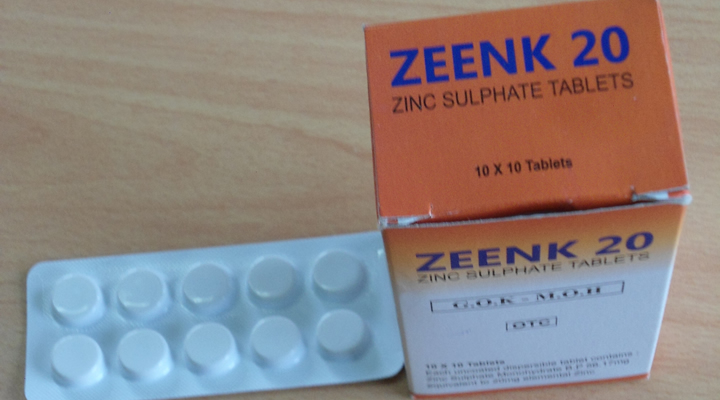
Zeenk
ZEENK 20MG DISPERSIBLE TABLETS.
Category: Over The Counter.
COMPOSITION:
Each dispersible tablet contains 54.90mg of Zinc sulphate Monohydrate B.P equivalent to 20mg of elemental zinc.
Product contains Aspartame.
Administration:
Place the tablet in a teaspoon. Add a bit of water. Let the tablet dissolve (around 45 seconds). Give the entire spoonful to the child.
Pharmacological Properties:
Pharmacodynamics:
Zinc is an essential trace element involved in many enzyme systems. Severe deficiency causes skin leision, alopecia, diarrhoea, increased susceptibility to infections and failure to thrive in children. Symptoms of less severe deficiency include distorted or absent perceptions of taste and smell and poor wound healing.
Pharmacokinetics:
Zinc is absorbed from the gastrointestinal tract and distributed throughout the body. The highest concentrations occur in hair, eyes, male reproductive organs and bone. Lower levels are present in liver, kidney and muscle. In blood 80% is found in erythrocytes. Plasma zinc levels range from 70 to 110μg/dL and about 50% of this is loosely bound to albumin. About 7% is amino-acid bound and the rest is tightly bound to alpha 2-macroglobulins and other proteins.
Indications:
For the treatment of diarrhoea, especially for children from 2 months to 5 years of age in connection with Oral Rehydration Salts
For the treatment of zinc deficiency.
Contraindications:
Contains a source of phenylalanine. May be harmful for people with phenylketonuria.
Side effects:
Zinc salts may cause abdominal pain, dyspepsia, nausea, vomiting, diarrhoea, gastric irritation and gastritis. There have also been cases of irritability, headache and lethargy observed.
Interactions:
- Tetracycline Antibacterials: Zinc may reduce the absorption of concurrently administered tetracyclines, and vice versa; when both are being given, an interval of at least three hours should be allowed.
- Quinolone Antibacterials: Zinc may reduce the absorption of quinolones i.e. ciprofloxacin, levofloxacin, moxifloxacin, norfloxacin and ofloxacin.
- Calcium Salts: The absorption of zinc may be reduced by calcium salts.
- Iron: The absorption of zinc may be reduced by oral iron and vice versa.
- Penicillamine: The absorption of zinc may be reduced by penicillamine and vice versa.
- Trientine: The absorption of zinc may be reduced by trientine and vice versa.
Pregnancy and Lactation:
The safety of this product in human pregnancy has not been established. Zinc crosses the placenta and is present in breast milk.
Special warning:
Accumulation of zinc may occur in cases of renal failure.
Overdose:
Zinc sulphate is corrosive in overdosage. Symptoms are corrosion and inflammation of the mucous membrane of the mouth and stomach; ulceration of the stomach followed by perforation may occur. Gastric lavage and emesis should be avoided. Demulcents such as milk should be given. Chelating agents such as sodium calcium edetate may be useful.
Dosage:
- Diarrhoea: Infants between 2 to 6 months- 10mg elemental Zinc once daily for 10-14days.
- Children between 6months to 5years of age: 20mg elemental Zinc once daily for 10-14days.
Other Indications:
- Children under 10 kg: 10mg elemental Zinc 2 times daily.
- Children within 10 to 30kg: 20mg elemental Zinc 1-3 times daily.
- Adult and children over 30kg: 40mg elemental Zinc 1-3 times daily.
Presentation
Blister Packs of 10×10’s in unit boxes .
Storage:
Do not store above 30°C . Store in a dry place. Protect from direct sunlight. Keep out of reach of children.